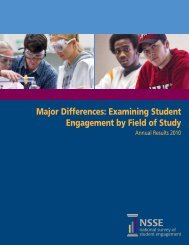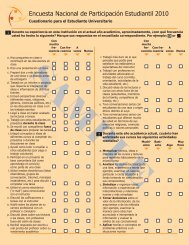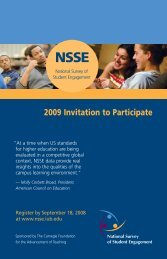Conceptual Framework and Overview of Psychometric Properties
Conceptual Framework and Overview of Psychometric Properties
Conceptual Framework and Overview of Psychometric Properties
Create successful ePaper yourself
Turn your PDF publications into a flip-book with our unique Google optimized e-Paper software.
included six additional questions <strong>and</strong> Form Bincluded six different additional questions.Students in the non-respondent sample werer<strong>and</strong>omly assigned a priori to one <strong>of</strong> twogroups. Those in Group 1 were interviewedusing Form A <strong>and</strong> those in Group 2 wereinterviewed using Form B. This procedureallowed us to ask a substantial number <strong>of</strong>questions from the survey without making theinterview too long to jeopardize reliability <strong>and</strong>validity.CSR staff r<strong>and</strong>omly selected between 100 <strong>and</strong>200 students from each school (based on totalundergraduate enrollment) who were judgedto be non-respondents by mid-April 2001.That is, those classified as non-respondentshad been contacted several times <strong>and</strong> invitedto complete The College Student Survey buthad not done so. The goal was to interview atleast 25 non-respondents from each <strong>of</strong> the 21institutions for a total <strong>of</strong> 525.Data were collected using the University <strong>of</strong>California Computer-Assisted SurveyMethods s<strong>of</strong>tware (CASES). All interviewershad at least 20 hours <strong>of</strong> training ininterviewing techniques <strong>and</strong> an additionalhour <strong>of</strong> study-specific training using theNSSE Non-Respondent Interview protocol.Students with confirmed valid telephonenumbers were called at least a dozen times,unless the respondent refused or insufficienttime remained before the end <strong>of</strong> the study.Multivariate analysis <strong>of</strong> variance was used tocompare the two groups <strong>of</strong> respondents <strong>and</strong>non-respondents from the respective schoolson 21 engagement <strong>and</strong> 3 demographic itemsfrom The College Student Report. Theanalyses were conducted separately for firstyear<strong>and</strong> senior students. The total numbers <strong>of</strong>students with complete usable information forthis analysis were as follows: first-yearrespondents = 3,470 <strong>and</strong> non-respondents =291, <strong>and</strong> senior respondents = 3,391 <strong>and</strong> nonrespondents=199.Compared with first-year respondents, firstyearnon-respondents scored higher on ninecomparisons. First-year respondents scoredhigher on only three items (using e-mail tocontact an instructor, writing more papersfewer than 5 pages, <strong>and</strong> taking more classesthat emphasized memorization). There wereno differences on 7 <strong>of</strong> the 21 comparableitems. For seniors, non-respondents againappeared to be somewhat more engaged thanrespondents as they scored higher on six itemswhile senior respondents scored higher on thesame three items as their first-yearcounterparts (using e-mail to contact aninstructor, writing more papers fewer than 5pages long, taking more classes thatemphasized memorization). No differenceswere found on more than half (11) <strong>of</strong> theitems.Overall, it appears that undergraduate studentswho do not complete the NSSE survey wheninvited to do so may be slightly more engagedthan respondents. This is counter to whatmany observers believe, that non-respondentshave a less educationally productiveexperience <strong>and</strong>, as a result, do not respond tosurveys. The findings from the telephoneinterviews suggest that the opposite may betrue, that non-respondents are busier in manydimensions <strong>of</strong> their lives <strong>and</strong> don=t take timeto complete surveys.At the same time we must exercise duecaution in drawing firm conclusions fromthese results. Telephone interviews typicallyare associated with a favorable mode effect,meaning that those interviewed <strong>of</strong>ten respondsomewhat more positively to telephonesurveys than when answering the samequestions on a paper questionnaire (Dillman,Sangster, Tarnai & Rockwood, 1996). Thus, itappears that few meaningful differences existbetween respondents <strong>and</strong> non-respondents interms <strong>of</strong> their engagement in educationallyeffective practices.<strong>Framework</strong> & <strong>Psychometric</strong> <strong>Properties</strong>Page 13 <strong>of</strong> 26



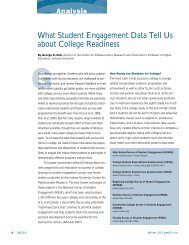

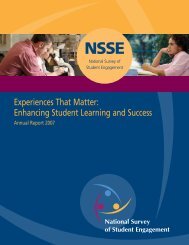
![Cuestionario para el Estudiante Universitarioâ[consent] - NSSE](https://img.yumpu.com/41728892/1/190x245/cuestionario-para-el-estudiante-universitarioaconsent-nsse.jpg?quality=85)
